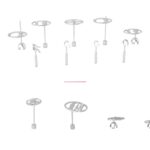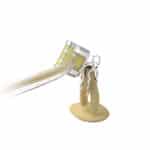
MED-EL
Published Nov 21, 2024
VIBRANT SOUNDBRIDGE: The Better Solution for Mixed Hearing Loss?
A bone conduction implant or an active middle ear implant? This is a common question in clinical treatment of mixed hearing loss, and there is considerable overlap in the indications for these two systems. But there are clear differences in how these two systems function—and, in some cases, also audiological results.

One reason why bone conduction systems are often chosen when in doubt is simply because they are much more well-known and more common. While there is a wide variety of different types and brands of active bone conduction implants to choose from, VIBRANT SOUNDBRIDGE (VSB) is the only active middle ear implant authorized for mixed hearing loss on the market.
Sticking to what’s tried and true and the assumption that it’s advantageous to go with an implant that can cover and treat all cases of mixed hearing loss shouldn’t prevent us from recognizing that, when it comes to performance and audiological outcomes, VSB is superior to bone conduction systems in some cases. This is especially true for more severe cases of mixed hearing loss.
In this article, we want to shed light on when SOUNDBRIDGE may be a better solution than a bone conduction implant and what unique benefits it can provide users.
What Sets SOUNDBRIDGE Apart From Bone Conduction Implants?
An active middle ear implant like VIBRANT SOUNDBRIDGE transmits vibrations directly to the middle or inner ear. Unlike bone conduction implants, the vibrating transducer is not anchored to the temporal bone—it is attached directly to one of the tiny, vibratory structures in the ear. This makes the application of the vibrations more powerful and targeted than with a bone conduction implant. The advantage is that SOUNDBRIDGE’s stimulation is targeted to a specific side, which eliminates the chance of crosstalk on the other side. This makes real binaural hearing possible.
For preoperative bone conduction hearing thresholds close to the normal range, this conceptual difference between the two implant designs does not have much of an effect. However, it does when it comes to high degrees of hearing loss. Although bone conduction implants are also able to generate enough vibration, this theoretical output essentially does not have any added benefit above a certain level: Special algorithms are required to suppress the feedback to the microphones created by the strong vibrations. This prevents utilization of the implant’s entire performance potential.
Especially Efficient Above Thresholds of 35 dB
What exactly is the level at which a middle ear implant’s targeted, direct vibrations are more efficient and therefore result in better hearing outcomes? Mojallal et al. researched exactly that. Their retrospective analysis of the main cohort (n = 48) showed that people with VSB achieved better hearing results than people with percutaneous bone conduction implants if their preoperative bone conduction thresholds (PTA4) were higher than 35 dB.Mojallal, H., Schwab, B., Hinze, A.-L., Giere, T., & Lenarz, T. (2015). Retrospective audiological analysis of bone conduction versus round window vibratory stimulation in patients with mixed hearing loss. International Journal of Audiology, 54(6), 391–400. https://doi.org/10.3109/14992027.2014.986690[1]
Better Audiological Results With SOUNDBRIDGE
“Patients had better free-field aided thresholds than their BC thresholds, which indicates an improvement in inner-ear sensitivity (known as ‘overclosure’).”
Mojallal et al., 2015
All study participants could approximately reach the mean BC threshold in a free-field condition. The VSB users had better aided inner ear thresholds than they did in the preoperative condition: They demonstrated not only a closure effect (closing the air-bone gap) but also an additional overclosure effect. The overclosure effect occurs when, in addition to the conductive hearing loss component, the sensorineural hearing loss component of their mixed hearing loss could also be partially compensated.
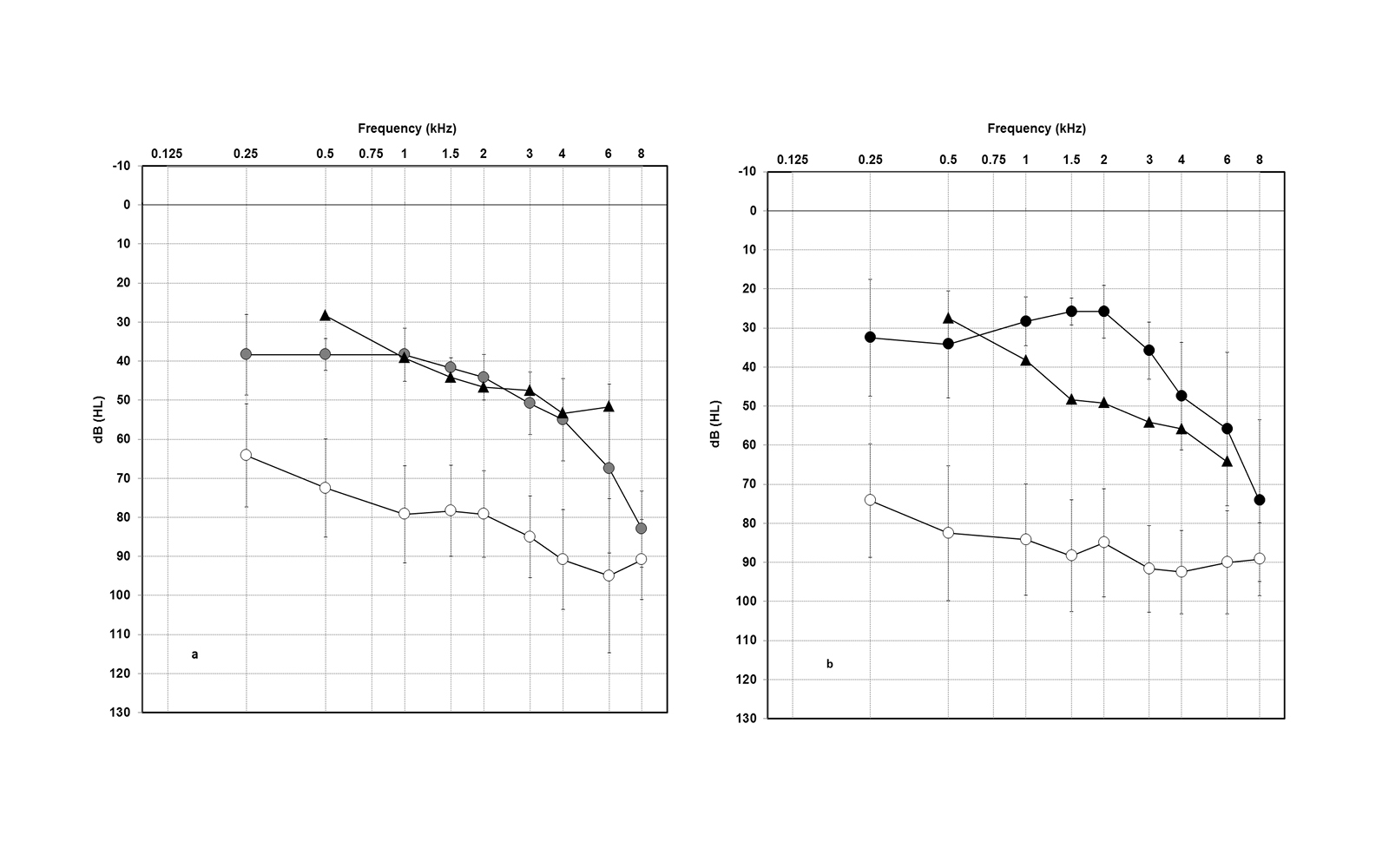
Both diagrams show that all participants had similar unaided bone conduction and free field thresholds. In the diagram on the left showing the percutaneous bone conduction implant (BAHA bone-anchored hearing aid), the closure effect can be seen: The line with the filled-in gray circles (treated free field thresholds) largely corresponds to the black triangles (unaided bone conduction thresholds). In the diagram on the right about VIBRANT SOUNDBRIDGE, the overclosure effect can be seen clearly: The treated free field thresholds are significantly better than the unaided bone conduction thresholds.
Like the preoperative free-field measurements, both groups had similar unaided word recognition scores.Mojallal, H., Schwab, B., Hinze, A.-L., Giere, T., & Lenarz, T. (2015). Retrospective audiological analysis of bone conduction versus round window vibratory stimulation in patients with mixed hearing loss. International Journal of Audiology, 54(6), 391–400. https://doi.org/10.3109/14992027.2014.986690[1] After treatment, however, the results—at 65 dB and 80 dB—differed significantly:
- 82% (at 65 dB) and 93% (at 80 dB) with VIBRANT SOUNDBRIDGE
- 56% (at 65 dB) and 82% (at 80 dB) with the percutaneous bone conduction implant
Another interesting finding of the study is that based on the relationship between word recognition score and bone conduction threshold, a conclusion can be drawn about the threshold up to which a bone conduction implant makes sense. Taking 75% as the standard for good speech understanding, one can see that for bone conduction thresholds of 35 dB and above, only VIBRANT SOUNDBRIDGE can provide sufficient results.
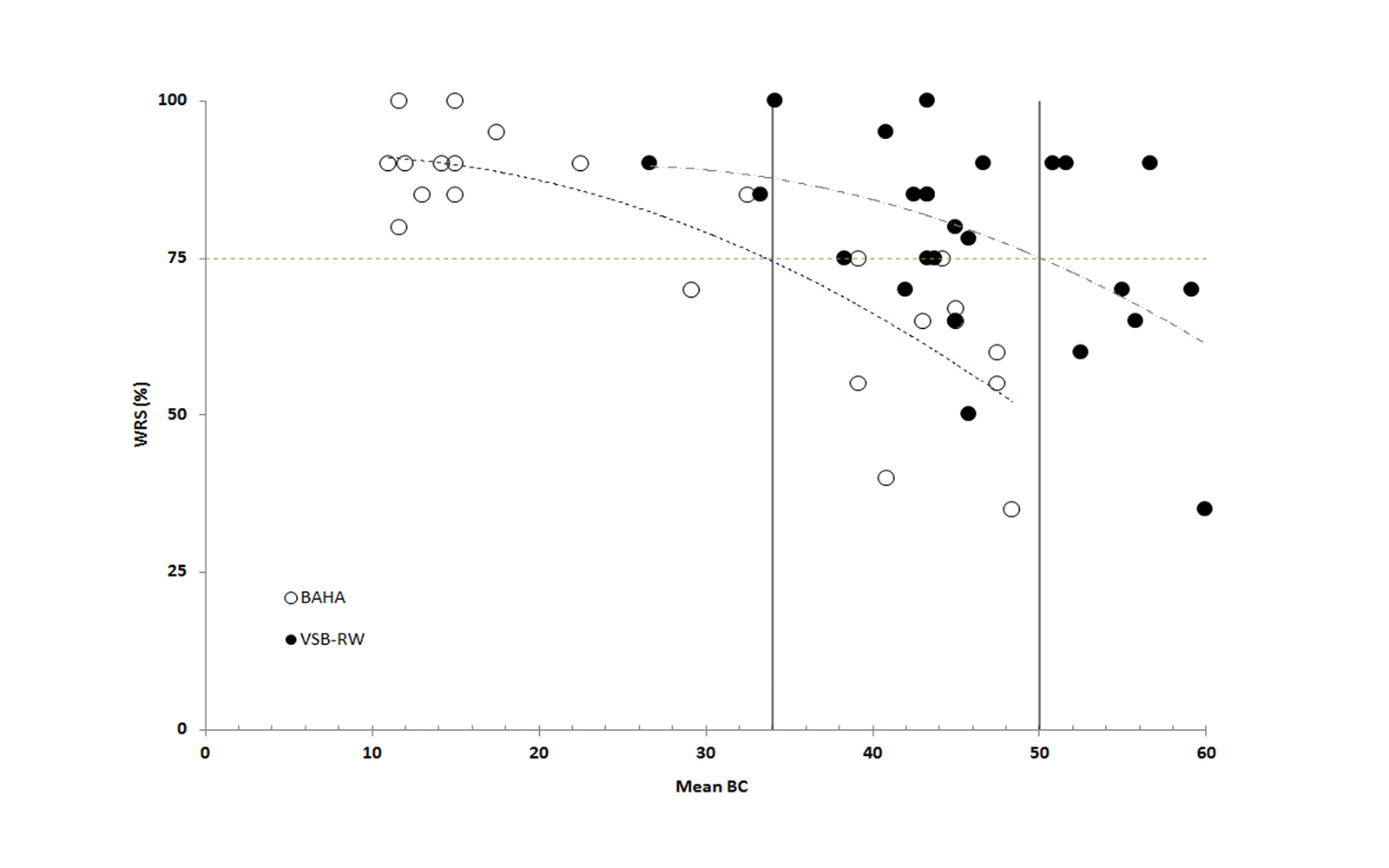
Word recognition scores with VSB (black dots) and BAHA (white dots)—important here are the intersections of the dashed polynomial trend line (BAHA left, VSB right) and the 75 % word recognition score line. These intersections represent the preoperative bone conduction (PTA4) threshold for each hearing solution. Even with an unaided bone conduction threshold of up to 50 dB, VSB users achieved word recognition scores of 75% (measured at 65 dB SPL). In the BAHA group, only people with maximum unaided bone conduction thresholds of 34 dB achieved these scores.
Implications for Active, Transcutaneous Bone Conduction Implants
A current study by Arndt et al. indicates that the results of the Mojallal et al. study comparing VIBRANT SOUNDBRIDGE to percutaneous bone conduction implants also generally applies to transcutaneous, active bone conduction implants. According to Arndt et al., the active, transcutaneous Osia® bone conduction implant reached performance limits at a bone conduction threshold above 40 dB (PTA4).Arndt, S., Wesarg, T., Aschendorff, A., Speck, I., Hocke, T., Jakob, T. F., & Rauch, A.-K. (2023). Prediction of postoperative speech comprehension with the transcutaneous partially implantable bone conduction hearing system Osia®. HNO, 72(S1), 1–9. https://doi.org/10.1007/s00106-023-01337-3[2]
A total of 29 people (seven implanted bilaterally) took part in this study. Patients with bone conduction thresholds ≥ 40 dB HL were only slightly above the German CI indications when treated (WRS were worse than 60% at 65 dB SPL and with optimal treatment).
“Our results revealed, in particular, that patients with a BC-PTA4 ≥ 40 dB HL, who thus had a limited dynamic range of ≤ 30 dB, tended to achieve a WRS with Osia that differed only slightly from the current cochlear implant indication of a WRS ≤ 60% WRS at 65 dB SPL in best aided condition [current German CI guidelines].”
Arndt et al., 2023
Limited Predictability of Success Above 40 dB
The authors concluded that the 55 dB HL (BC-PTA4) indication limit for Osia® should be considered “individually and critically.” The prediction models showed that “the maximum possible treatable average BC hearing threshold should be reduced to 45 dB HL, or even 40 dB HL, in order to achieve sufficient aided speech recognition and to ensure tolerance regarding potential progression of HL.”
For average treatable bone conduction thresholds of a maximum of 40 dB, the predictability of successfully treating sensorineural and mixed hearing loss is higher with a bone conduction implant. For bone conduction thresholds ≥ 40 dB HL, it is important to explain to candidates the “poorer predictability for their case and the potential non-achievement of the preoperative mWRS.”Arndt, S., Wesarg, T., Aschendorff, A., Speck, I., Hocke, T., Jakob, T. F., & Rauch, A.-K. (2023). Prediction of postoperative speech comprehension with the transcutaneous partially implantable bone conduction hearing system Osia®. HNO, 72(S1), 1–9. https://doi.org/10.1007/s00106-023-01337-3[2]
Stimulation Targeted to a Particular Side for Binaural Hearing
Depending on the transcranial attenuation and the contralateral hearing loss, bone conduction implants can cause transcranial crosstalk, which has an effect, among other things, on directional hearing. In contrast, VSB enables binaural hearing with stimulation specific to each side.
Agterberg et al. studied this phenomenon by comparing the localization capabilities of bilateral bone conduction implant users with those of bilateral VSB users. Agterberg, M. J. H., Straatman, L., Bruchhage, K.-L., Jürgens, T., Hollfelder, D., & Leichtle, A. (2024). The merits of bilateral application of middle ear implants in patients with bilateral conductive and/or mixed hearing loss. Trends in Hearing, 28,1-10. https://doi.org/10.1177/23312165241264466[3] They tested how exactly participants could tell where a sound was coming from (-90° bis +90°) at sound levels of 45 dBA, 55 dBA and 65 dBA.
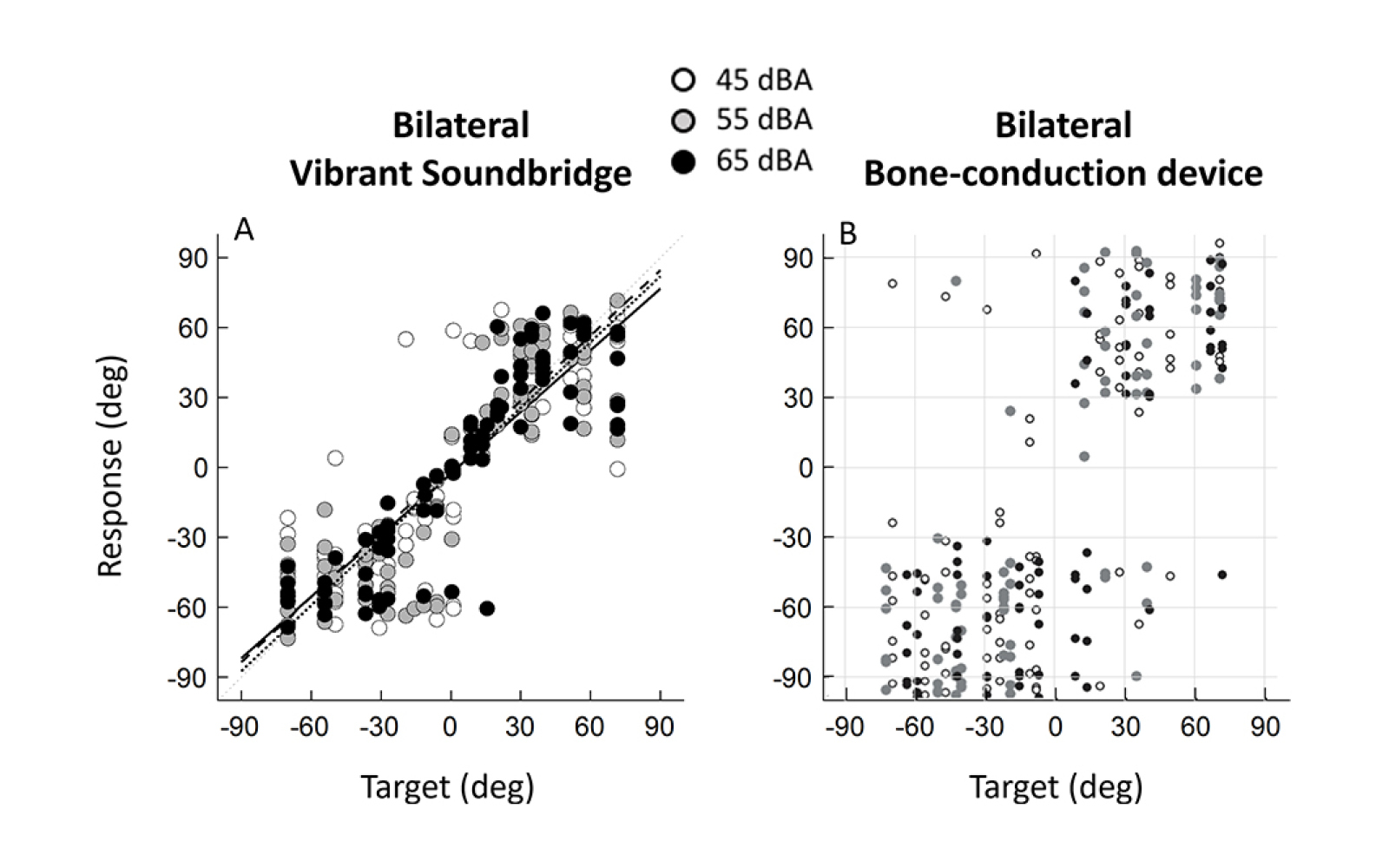
Localization abilities of bilateral VSB users (left) compared to bilateral bone conduction implant users (right)
The comparison showed some significant differences:
- Sound localization was significantly better with VIBRANT SOUNDBRIDGE middle ear implants than with bone conduction implants.
- The bone conduction implant only facilitated lateralization, whereas the middle ear implants facilitated localization.
- Individuals with two middle ear implants could even correctly localize very quiet sounds. They achieved results similar to those of normal hearing individuals.
Agterberg et al. ascribed the significantly better localization abilities of the middle ear implant group to the fact that, as opposed to bone conduction implants, middle ear implants are placed directly on the ossicular chain or round window and therefore only stimulate the corresponding cochlea.Agterberg, M. J. H., Straatman, L., Bruchhage, K.-L., Jürgens, T., Hollfelder, D., & Leichtle, A. (2024). The merits of bilateral application of middle ear implants in patients with bilateral conductive and/or mixed hearing loss. Trends in Hearing, 28,1-10. https://doi.org/10.1177/23312165241264466[3]
Mixed Hearing Loss: Bone Conduction Implants or Middle Ear Implants?
These studies show that bone conduction implants can offer efficient treatment for individuals with mixed hearing loss but are limited above certain levels of hearing loss. In such cases, VIBRANT SOUNDBRIDGE is a better solution from an audiological perspective because it is not only powerful but also generates targeted vibrations that can be transmitted directly to the inner ear without feedback, distortion, or crosstalk compromising sound quality. Individuals with preoperative bone conduction thresholds above 35 dB can benefit more from VIBRANT SOUNDBRIDGE than from bone conduction implants and achieve better postoperative speech recognition.
For the sake of completeness, it is important to mention that implant selection is not based solely on audiological parameters. There can, therefore, be good reasons for someone with bone conduction thresholds above 35 dB to receive a bone conduction implant.
As a result, a broad implant portfolio containing options to suit any patient should contain both bone conduction implant systems and middle ear implant systems.
Interested in VIBRANT SOUNDBRIDGE for Mixed Hearing Loss?
Have we piqued your interest in the unique VIBRANT SOUNDBRIDGE middle ear implant system? Don’t hesitate—contact your local MED-EL representative for more information.
Fore more information, you can also check out our previous articles on SOUNDBRIDGE for Mixed Hearing Loss and straightforward VSB surgery with the Stapes-SH-Coupler.
Stay Up to Date
Subscribe to the MED-EL Professionals Blog and get exciting articles and product information related to audiology, ENT surgery, and hearing rehabilitation sent directly to your email inbox.
SubscribeReferences
-
[1]
Mojallal, H., Schwab, B., Hinze, A.-L., Giere, T., & Lenarz, T. (2015). Retrospective audiological analysis of bone conduction versus round window vibratory stimulation in patients with mixed hearing loss. International Journal of Audiology, 54(6), 391–400. https://doi.org/10.3109/14992027.2014.986690
-
[2]
Arndt, S., Wesarg, T., Aschendorff, A., Speck, I., Hocke, T., Jakob, T. F., & Rauch, A.-K. (2023). Prediction of postoperative speech comprehension with the transcutaneous partially implantable bone conduction hearing system Osia®. HNO, 72(S1), 1–9. https://doi.org/10.1007/s00106-023-01337-3
-
[3]
Agterberg, M. J. H., Straatman, L., Bruchhage, K.-L., Jürgens, T., Hollfelder, D., & Leichtle, A. (2024). The merits of bilateral application of middle ear implants in patients with bilateral conductive and/or mixed hearing loss. Trends in Hearing, 28,1-10. https://doi.org/10.1177/23312165241264466
References

MED-EL
Was this article helpful?
Thanks for your feedback.
Sign up for newsletter below for more.
Thanks for your feedback.
Please leave your message below.
CTA Form Success Message
Send us a message
Field is required
John Doe
Field is required
name@mail.com
Field is required
What do you think?
The content on this website is for general informational purposes only and should not be taken as medical advice. Please contact your doctor or hearing specialist to learn what type of hearing solution is suitable for your specific needs. Not all products, features, or indications shown are approved in all countries.

MED-EL

MED-EL


